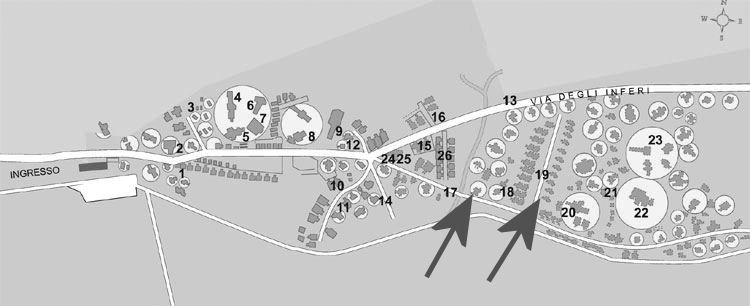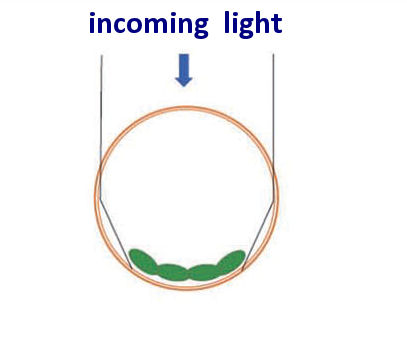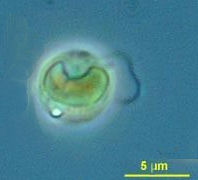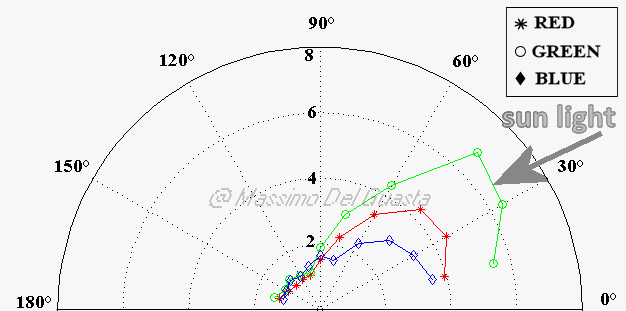 |
You are herei: _BioOptics Today is: 26-04-2024 | sei il visitatore numero: 4136 | |
 |

During some trips to the wonderful archaeological site of the Banditaccia necropolis (Cerveteri, Lazio, Italy), in addition to wandering among Etruscan tombs (as perhaps only in this magical place you can do..) I came across a truly amazing optical phenomenon.
I do not know the exact archaeological terms: the tombs have just the shape of the old italic huts: in Cerveteri are the huts of the dead in an underground city, and therefore each grave is a dark, semi-underground dome accessed by an opening, more or less less like a little door at home.
Many tombs are flooded with rainwater and have several centimeters of stagnant water on the bottom.
Looking back in 2009 to some of these flooded tombs, the first impression was that they were artificially illuminated by warm golden light. Many hurried passers-by had the same impression: I heard him shout it out loud. Then all passed over .....
The surface of the water seemed phosphorescent, a golden color that we are not used to. In such a suggestive place, then ....
The interior of a flooded tomb, photographed from the entrance, without flash: the superficial algal film sent back the coming from the outside towards the visitor facing the entrance, like a natural reflector |
|

A map of the parts of the Banditaccia archaeological site where I found (between 2010 and 2012) the "golden" graves from an algae film
In these images , taken by SEM electron microscope (Sesto Fiorentino scientific pole) many diatoms appear (then identified as Pseudostaurosira brevistriata) and some flagellate algae of about 15-25 um diameter
| SEM images of the algae. Although they are less numerous and hardly identifiable to me, the golden algae flagellated Chromulina sp. floating on the surface are responsible for the observed optical effect. The other algae present in the photos are diatoms, probably present in the mass of water more than on the surface, whithout producing any significant optical effects: It is Pseudostaurosira brevistriata (Williams, D.M. & Round, F.E. 1988. Revision of the genus Fragilaria, Diatom Research 2: 267-288). | |
An optical effect known for a long time
Investigating in the literature I discovered that this bio-optical effect, though fascinating and surprising (at least for the "magical" place in which I observed it), has long been known in the world of phytobiologists and optical enthusiasts. Until the beginning of the 1900', the scientist Gustav Stenn had discovered the relocation of chloroplasts in numerous species of plants and freshwater algae. The movement of the chloroplasts can occur either to escape excessive lighting (in which case they are repositioned inside the cell in order to intercept the minimum light intensity, making the cells "transparent", or to collect the maximum light in dark environments. In this case the chloroplasts are arranged so as to collect the maximum of the available light.It is the case of Chromulina, which often have only one cup-shaped chloroplast.The "cup is placed towards the light source in dark environments such as caves
 |
 |
| Chloroplast dislocation scheme ("Eschastrophe") as "retroreflectors" in a poorly lit environment | Chromulina nebulosa:a type of Chromulina with a single cup chloroplast. |
Other random discoverers of the phenomenon (not many, to be honest) I met on the web: http://www.upi-institut.de/_handschuhsheim/goldauf.htm https://atoptics.wordpress.com/tag/algae-optics/
|
|
...A NEW FIELD INVESTIGATION
|
I asked myself how effiicient was the backscatter effect of light from the algal film. The optical effect is so surprising to be worth a little DIY experimentation. Armed with an ordinary digital camera in 2011 I went again to one of the flooded graves presenting the algae film with an experiment in mind: |
 |
In each picture I varied about 15 ° (reading the inclination from the camera) the angle of elevation of the photo, trying to always work on the plane of incidence that passes through the center of the entrance of the tomb. The main problem was to avoid disturbing the surface of the water, that is, I had to do the footbalist with my feet on the emerged part of the tomb.
|
 |
On the right of the figure the entrance to the tomb, whose "center" was about 28 ° elevation. |